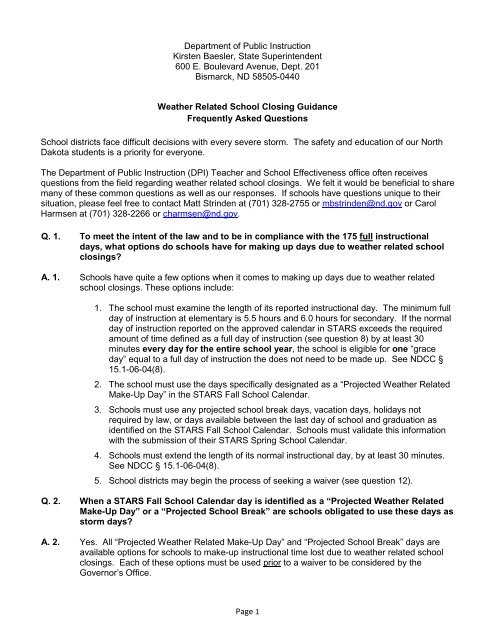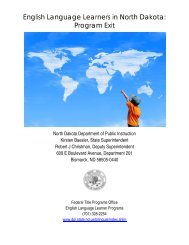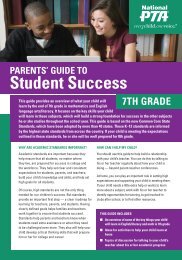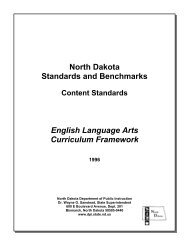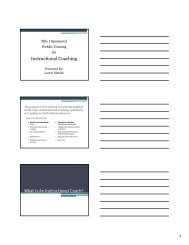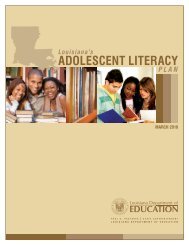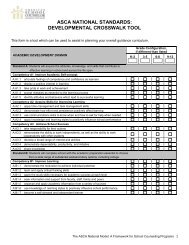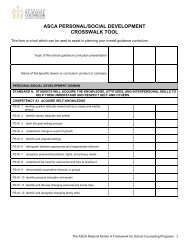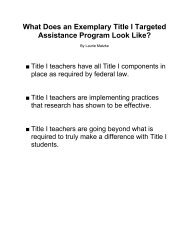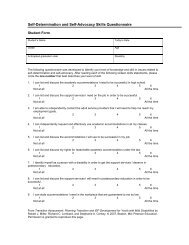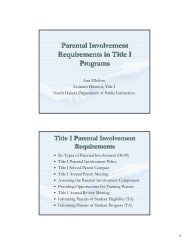Weather Related School Closing Guidance - North Dakota ...
Weather Related School Closing Guidance - North Dakota ...
Weather Related School Closing Guidance - North Dakota ...
You also want an ePaper? Increase the reach of your titles
YUMPU automatically turns print PDFs into web optimized ePapers that Google loves.
Department of Public Instruction<br />
Kirsten Baesler, State Superintendent<br />
600 E. Boulevard Avenue, Dept. 201<br />
Bismarck, ND 58505-0440<br />
<strong>Weather</strong> <strong>Related</strong> <strong>School</strong> <strong>Closing</strong> <strong>Guidance</strong><br />
Frequently Asked Questions<br />
<strong>School</strong> districts face difficult decisions with every severe storm. The safety and education of our <strong>North</strong><br />
<strong>Dakota</strong> students is a priority for everyone.<br />
The Department of Public Instruction (DPI) Teacher and <strong>School</strong> Effectiveness office often receives<br />
questions from the field regarding weather related school closings. We felt it would be beneficial to share<br />
many of these common questions as well as our responses. If schools have questions unique to their<br />
situation, please feel free to contact Matt Strinden at (701) 328-2755 or mbstrinden@nd.gov or Carol<br />
Harmsen at (701) 328-2266 or charmsen@nd.gov.<br />
Q. 1. To meet the intent of the law and to be in compliance with the 175 full instructional<br />
days, what options do schools have for making up days due to weather related school<br />
closings?<br />
A. 1. <strong>School</strong>s have quite a few options when it comes to making up days due to weather related<br />
school closings. These options include:<br />
1. The school must examine the length of its reported instructional day. The minimum full<br />
day of instruction at elementary is 5.5 hours and 6.0 hours for secondary. If the normal<br />
day of instruction reported on the approved calendar in STARS exceeds the required<br />
amount of time defined as a full day of instruction (see question 8) by at least 30<br />
minutes every day for the entire school year, the school is eligible for one “grace<br />
day” equal to a full day of instruction the does not need to be made up. See NDCC §<br />
15.1-06-04(8).<br />
2. The school must use the days specifically designated as a “Projected <strong>Weather</strong> <strong>Related</strong><br />
Make-Up Day” in the STARS Fall <strong>School</strong> Calendar.<br />
3. <strong>School</strong>s must use any projected school break days, vacation days, holidays not<br />
required by law, or days available between the last day of school and graduation as<br />
identified on the STARS Fall <strong>School</strong> Calendar. <strong>School</strong>s must validate this information<br />
with the submission of their STARS Spring <strong>School</strong> Calendar.<br />
4. <strong>School</strong>s must extend the length of its normal instructional day, by at least 30 minutes.<br />
See NDCC § 15.1-06-04(8).<br />
5. <strong>School</strong> districts may begin the process of seeking a waiver (see question 12).<br />
Q. 2. When a STARS Fall <strong>School</strong> Calendar day is identified as a “Projected <strong>Weather</strong> <strong>Related</strong><br />
Make-Up Day” or a “Projected <strong>School</strong> Break” are schools obligated to use these days as<br />
storm days?<br />
A. 2. Yes. All “Projected <strong>Weather</strong> <strong>Related</strong> Make-Up Day” and “Projected <strong>School</strong> Break” days are<br />
available options for schools to make-up instructional time lost due to weather related school<br />
closings. Each of these options must be used prior to a waiver to be considered by the<br />
Governor’s Office.<br />
Page 1
Q. 3. Are schools expected to use “Projected Professional Development Days” as identified on<br />
the STARS Fall <strong>School</strong> Calendar as possible weather related make-up days?<br />
A. 3. State law requires that two professional development days be built into the STARS Fall <strong>School</strong><br />
Calendar. See NDCC § 15.1-06-04(3). If a school has more than two days planned for<br />
professional development, these additional days are available options for schools to make-up<br />
instructional time lost due to weather related school closings.<br />
Q. 4. A school currently has an extra 15 minutes built into the school day on the STARS Fall<br />
<strong>School</strong> Calendar. When combined over the course of the school year, this equals<br />
enough time for half of a school day. Can this time be used toward weather related<br />
school closings?<br />
A. 4. No. State law indicates the additional time must total 84 hours in order to be used towards<br />
addressing weather related school closings. See NDCC § 15.1-06-04(8).<br />
In the past, this practice was referred to as “banking time”. In a past Attorney General Opinion,<br />
it was determined that this practice is not allowed. See Attorney General Opinion 1997-L-100.<br />
In addition, this had historically been an issue across the state; therefore, the legislature<br />
attempted to settle this issue by putting into place our current NDCC regulations.<br />
Q. 5. A school currently has an extra 20 minutes built into the school day on the STARS Fall<br />
<strong>School</strong> Calendar. The school would like to exercise the option of adding an additional 30<br />
minutes of instructional time to the school day. In this scenario, would it be possible for<br />
the school to add an additional 10 minutes a day to fulfill the requirement that additional<br />
time must be added in 30 minute increments?<br />
A. 5. No. State law clearly indicates that the “normal” school day would need to be extended by 30<br />
minutes. In the scenario outlined above, the extra 20 minutes is considered part of the “normal”<br />
school day as submitted on the STARS Fall <strong>School</strong> Calendar. See NDCC § 15.1-06-04(8).<br />
Q. 6. Can a school “bank time” for weather related school closings?<br />
A. 6. No. In a past Attorney General’s Opinion, it was determined that the practice of “banking time”<br />
was not allowed. See Attorney General Opinion 1997-L-100. In addition, this practice had<br />
historically been an issue across the state; therefore, the legislature attempted to settle this<br />
issue by putting into place our current NDCC regulations.<br />
Q. 7. When a school is making up additional time due to weather related school closings, does<br />
it matter whether the additional time is added to the beginning or end of the school day?<br />
A. 7. No. The law is silent on the manner in which the make-up time is incorporated into the school<br />
day; however, the time must be instructional and must be provided at a minimum of 30 minutes.<br />
See NDCC § 15.1-06-04(8).<br />
Page 2
Q. 8. How is a full-day of instruction defined in statute?<br />
A. 8. For elementary settings, a full day of instruction is defined as at least 5.5 hours of time<br />
dedicated for curricular instruction. This excludes non-instructional time such as recess, lunch,<br />
etc. See NDCC § 15.1-06-04(5) and Attorney General Opinion 1997-L-100.<br />
For secondary settings, a full day of instruction is defined as at least 6.0 hours of time dedicated<br />
for curricular instruction. Non-instructional time for lunch and passing time between classes<br />
cannot be counted as part of the instructional day. In addition: zero hour and early bird classes<br />
are not counted as part of the normal instructional day for the purpose of qualifying for the<br />
“grace day” because it is not a requirement for all students. See NDCC § 15.1-06-04(5) and<br />
Attorney General Opinion 1997-L-100.<br />
Q. 9. Can a school add additional time to the school day in lieu of utilizing the school’s<br />
designated “Projected <strong>Weather</strong> <strong>Related</strong> Make-Up Days” or “Projected <strong>School</strong> Breaks”?<br />
A. 9. No. Before adding additional instructional time to the school day, schools must utilize each of<br />
their “Projected <strong>Weather</strong> <strong>Related</strong> Make-Up Days”, “Projected <strong>School</strong> Breaks”, vacation days,<br />
holidays not required by law, or days available before graduation as identified on the STARS<br />
Fall <strong>School</strong> Calendar.<br />
Q. 10. Can a school add additional time to the school day in anticipation or preparation for<br />
upcoming weather related school closings?<br />
A. 10. No. Statute does not allow for a school to increase the length of the school day by a fraction of<br />
a school day in anticipation that there may be a future reason to dismiss school. See Attorney<br />
General Opinion 1997-L-100.<br />
Q. 11. Are schools responsible for making up time for starting the school day late or dismissing<br />
early due to weather related issues?<br />
A. 11. Yes. All instructional hours missed during the school day must be made up. See NDCC § 15.1-<br />
06-04(8).<br />
Page 3
Q. 12. What process must schools follow to seek the storm forgiveness waiver through DPI and<br />
the Governor’s Office?<br />
A. 12. Before the Request for Emergency Declaration State Aid Eligibility (SFN 51826) (a.k.a. storm<br />
forgiveness waiver) can be submitted and is eligible for review by the Governor’s Office, the<br />
school district must:<br />
1. Account for, and utilize, two or more weather related closure days as indicated in their<br />
STARS Fall <strong>School</strong> Calendar.<br />
2. Provide a <strong>School</strong> Calendar Amendment Request in the form of a memo or letter to the<br />
Department of Public Instruction demonstrating that the district has made every attempt<br />
to ensure 175 full instructional days are provided to their students. The <strong>School</strong> Calendar<br />
Amendment Request must show the district’s plan for exhausting all eligible and<br />
potential instructional days remaining in the school calendar. These dates may include<br />
non-mandated holidays (please reference NDCC § 15.1-06-02 – <strong>School</strong> Holidays),<br />
preplanned breaks, or days between last day of school and scheduled high school<br />
graduation.<br />
3. Exercise all options outlined in the district’s <strong>School</strong> Calendar Amendment Request. A<br />
district’s undue hardship rationale and Request for Emergency Declaration State Aid<br />
Eligibility (SFN 51826) (http://www.dpi.state.nd.us/forms/sfn51826.pdf) will only be<br />
considered after the school district has exercised all options outlined in their <strong>School</strong><br />
Calendar Amendment Request.<br />
Q. 13. If a school district receives the Governor’s forgiveness of a school day due to weather<br />
related school closure, is the district’s state aid payment reduced accordingly?<br />
A. 13. No. If the Governor determines that a day will be forgiven, state aid continues to be calculated<br />
as if school were in session. However, if the Governor denies forgiveness and the school is<br />
unable to make up the lost day, state aid will be reduced accordingly.<br />
Q. 14. If a school district makes the decision to extend the school year beyond the date set for<br />
graduation due to weather related closings, will state aid payments be impacted?<br />
A. 14. No. Extending the school calendar beyond graduation to account for the required 175<br />
instructional days has no impact on state aid payments. These additional days would qualify for<br />
state aid payment, just the same as any other of the 175 instructional days.<br />
Revised February 24, 2014<br />
Page 4


